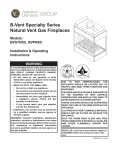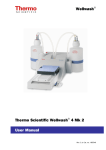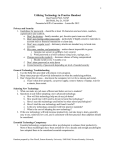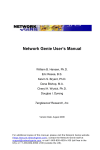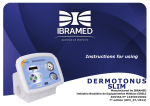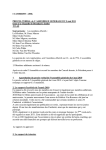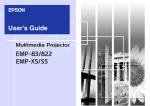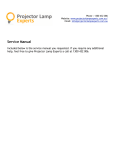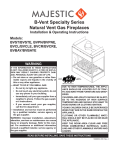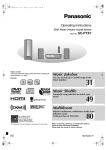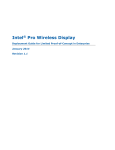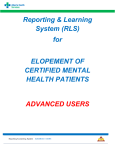Download PBS “To Go”
Transcript
Training Funded by Kansas Department for Aging and Disability Services KIPBS@KU 2015 1 Table of Contents Introduction…………………………............3-6 Quality of Life………………………………...7-13 Prevention……………………………………...14-22 Person Centered Planning…………….23-31 Applied Behavior Science……………….32-43 Tying it All Together………………………44-47 Cultural Competence………………….....56-59 PBS “To Go”Box Training Manual for Mental Health Center Staff……...60-115 KIPBS@KU 2015 2 Level of Activities The activities contained in this workbook are organized by the level of experience and consultation necessary. Green pages indicate content or activities appropriate for anyone—even those new to PBS. Yellow pages indicate content or activities that caregivers should do in collaboration with a professional partner who has background or experience in PBS. Red pages indicate content or activities that are best done with an intensively-trained PBS Facilitator. Intensive Activities: Intermediate Activities: Introduction Level Activities: Do With A Professional Do With A PBSTrained Professional Do On Your Own KIPBS@KU 2015 3 PBS Workbook for Caregivers and Professionals Purpose The aim of this workbook is to help providers and caregivers apply PBS principals with children who have challenging behaviors. This has been designed as a supplemental activity book for families. The activities are intended to be done in collaboration with a professional service provider (mental health worker or other trained behavior service provider) and in conjunction with other services a child may already be receiving. Objectives 1. To support families with implementation of Positive Behavior Support strategies with their children at home and in their communities; 2. To provide parents and other caregivers with awareness- level knowledge of PBS strategies; 3. To promote consistent implementation and sustainability of effective behavior plans. Electronic copies of this workbook can be found on the KMHPBS website’s (www.kmhpbs.org) families resource page. KIPBS@KU 2015 4 What is Positive Behavior Support? KIPBS@KU 2015 5 PBS is preventative and proactive Preventative and Proactive Being proactive means stopping behavior problems before they even start! We want to set up environments that make problem behavior unnecessary. Some of the tools we use to do this include Applied Behavior Science, Person-Centered Planning, and a focus on Quality of Life. PBS uses Applied Behavior Science Applied Behavior Science All behaviors serve a purpose. When trying to determine the purpose of an individual’s behavior, trained professionals use a systematic approach. This means they use observations, interviews, and data collection systems in order to hypothesize why your child’s behaviors are occurring. PBS professionals use this information to teach new behaviors and implement effective behavior support plans. KIPBS@KU 2015 6 PBS uses Person-Centered Planning to Improve Quality of Life Person-Centered Planning Doing effective positive behavior support means getting to know your child well. What are their strengths and preferences? What motivates them? Behavior plans that are not individualized for your child won’t be as successful. Quality of Life PBS approaches always consider the impact on your child’s quality of life and the quality of life of your family. If interventions and supports don’t enhance your family’s quality of life, why do them? KIPBS@KU 2015 7 As we work through this book, you will learn how these different elements come together to make a good PBS plan. Each part of the plan informs and helps other parts of the plan. They all work together, like four legs that hold up a table. How does behavior impact Quality of Life? Prevention and Setting Clear Expectations Person-Centered Planning PBS Plan Behavior Planning Using Applied Behavior Science Enhancing Quality of Life “If a child doesn’t know how to read, we teach. If a child doesn’t know how to swim, we teach. If a child doesn’t know how to multiply, we teach. If a child doesn’t know how to drive, we teach. If a child doesn’t know how to behave, we... teach? ...punish?” John Herner, Counterpoint (1998, p.2) KIPBS@KU 2015 8 Considering Quality of Life… We don’t often think specifically about our own quality of life. What does it mean anyway? Robert Schalock (1996) described Quality of Life as a multidimensional construct that is defined when a person’s needs are met and when he or she has the same opportunities as other individuals without disabilities to pursue and achieve major life goals in home, school, work, and community settings. Ask yourself these questions… “Does our family have trouble going out to restaurants or other public places because of my child’s behavior?” “Does my child have friends that want to play with him?” “Does dealing with my child’s behavior get in the way of my work or the work of my spouse/partner?” Does my child’s behavior get in the way of him getting the education he needs and deserves?” “Do I feel my family can do most of the same things other families can do?” KIPBS@KU 2015 9 You can probably see that how you answer such questions says something about the impact of your child’s behavior on his quality of life and that of your family. Consider your family’s quality of life in the areas below: Quality of Life Areas (Domains) Common Indicators Contentment with Life Emotional Well-Being (EWB) Self-Concept Lack of Stress Interactions with Others Interpersonal Relations (IR) Relationships with Others Supports Financial Status Material Well-Being (MWB) Employment Housing Education Personal Development (PD) Personal Competence Performance Health Physical Well-Being (PWB) Activities Leisure Autonomy Self-Determination (SD) Opportunities for Choice Making Goals and Personal Values Community Integration & Participation Social Inclusion (SI) Community Roles Social Supports Basic Human Rights Rights (R) Legal Rights Schalock and Verdugo (2002) KIPBS@KU 2015 10 Behavior/QOL Exercises 1. 2. 3. We all engage in behaviors. Some behaviors improve our QOL Some behaviors negatively impact QOL We all learn behaviors. From our parents From our peers From our teachers From past experiences We all learn differently. Most learn from Universal Strategies Some require some Targeted Strategies A few need Intensive Strategies We have all used Universal, Targeted, and Intensive Strategies at some point. Our abilities, resources, environments, and care givers all impact our learning. KIPBS@KU 2015 11 Quality of Life Focus & Layered Interventions Example QOL DOMAIN Interpersonal Relations (IR) Example QOL INDICATOR • Interactions with Others • Relationships with Others PWB SD PD INDIVID UAL MWB R SI EWB IPR Behavior: Physical Aggression Impact on QOL Difficult to make friends because peers are scared child will be physically aggressive. • Supports Exercise: QOL DOMAIN QOL INDICATOR (Insert from page 10) (Insert from page 10) Behavior: ___________ Impact on QOL QOL Support Need Across Environments (Fill in the empty boxes with “possible” interventions) Types of Interventions: Universal Targeted At Home In the Community At Work or School Example: Teaching expectations at Home Example: Providing additional supervision or support in the community. Example: Implementing individualized intensive function based interventions. Individual (These would only be developed with the help of a trained PBS professional) KIPBS@KU 2015 12 Layered Positive Behavior Support System PBS is not just one intervention. It is a system that looks at all these layers of support… 3) Intensive individualized behavior supports To be developed and implemented by licensed professionals. 2) Specialized strategies Targeted for common problem situations; and 1) Universal strategies Proactive, preventative, positive teaching based strategies for staff and families to use. KIPBS@KU 2015 13 PBS starts with Prevention Ways to act preventatively or proactively include: Setting up the environment for success Creating clear expectations Practicing and rewarding behavior that meets the expectations Prevention and Setting Clear Expectations Person-Centered Planning PBS Plan Behavior Planning Using Applied Behavior Science Enhancing Quality of Life How do we set up environments that make problem behavior less likely? There are lots of ways that we set up environments to match the needs of the people in them. Waiting for an appointment can be hard for a young child. Creating a friendly space makes it easier. Think about other ways you can decrease the likelihood of problem behavior with your child at home or while in the community. KIPBS@KU 2015 14 Preventative Behavior Strategies KIPBS@KU 2015 15 Introduction Level Activity: Do On Your Own Thinking Preventatively What are some ways you already prevent problem behaviors and encourage desired behavior? Setting up the environment to prevent problem behaviors takes some careful thought. Try this exercise: Look around the rooms in which you and your family spend the most time. How many things are accessible to the child that they are not allowed to have or touch? These “set ups” are very hard for kids. In order to set kids up for success, we often have to change our environments to be more child-friendly. This doesn’t mean you have to change everything! But consider how you can create some friendly safe places where it is okay to play or relax. Some things I could probably change in my house that might help my child right away include: KIPBS@KU 2015 16 Setting Expectations Creating 3-5 expectations that everyone in the house can understand and do is a good first preventative step. The type of table below is often referred to as a behavior matrix. Notice how it describes the behavior you want to see, not what you don’t want to see. Respect Others’ Space Use Respectful Language Mealtime Car Rides Bedtime Stay in your seat. Stay in your own Stay in your own seat (wear your bed after 8:30. Eat your own food only. Use an inside voice. Say “please” and “thank you”. seat belt). Use a quiet voice Use a quiet voice. for safety. Use kind words or no words. Listen to others without interrupting. Help Out Check the chore chart Bring in all your Brush your teeth; and do your job for that belongings or get in PJs, and night. trash. pick out book first time asked. KIPBS@KU 2015 17 Reinforce these behaviors quickly and often! KIPBS@KU 2015 18 Introduction Level Activity: Do On Your Own Setting Expectations Exercise 1) Write 3 clear expectations in column one 2) Describe the behavior you want to see related to those expectations. 3) Describe how you plan to teach the behavior? 4) Describe how this behavior will be reinforced when you see it Expectation What does this look like? KIPBS@KU 2015 How will the behavior be taught? How will this be reinforced? 19 Watch your “No’s” and your “Don’ts!” Remember: Kids should always know what they can do and can have; not just what they can’t do. This doesn’t mean you will never use those words. But knowing what not to do is not the same as knowing what to do. Likewise, there should be some things that are never taken away (their security blanket, or their right to some one-on-one time with you). These assurances help children feel safe and loved, even when their behavior is not the best. If a child has lost a toy or privileges because of challenging behavior, make sure it is very clear how they can gain these things back. Remember, loss of a preferred item or activity should be time limited and possible to gain back. Once a child has nothing left to loose (or isn’t clear on how to make amends), there is no motivation for him to behave in a more desirable way. KIPBS@KU 2015 20 Introduction Level Activity: Do On Your Own Make a list of things your child has choices about during each of the routines below Morning: (may include a choice between 2-3 different breakfast foods or what to wear) After School: (may include whether to play inside or outside; or what activities they can usually expect to be able to do) Evening: (may include choices between watching TV or playing a game) Note: Of course, there will be times your child does have to do something (homework, chores). This is to be expected—having responsibilities is a good thing! But consider how choice can be built into non-preferred activities. Could they choose when or where to do some non-preferred things? Having choices decreases the likelihood of an argument. KIPBS@KU 2015 21 Person Centered Planning Prevention and Setting Clear Expectations Person-Centered Planning PBS Plan Behavior Planning Using Applied Behavior Science Enhancing Quality of Life What is a Person-Centered Plan? Person-Centered Planning is a process that allows the PBS Team to get to know your child and to hear about his goals and dreams. It allows the team to know what your child likes and dislikes and how the team can help him. In short, the PCP process gives your child a voice. It is a positive process in which he can speak about what’s important to him. KIPBS@KU 2015 22 Voice and Choice There are different types of individualized planning processes for kids. Your child may have an Individualized Education Plan (IEP) at school or a Wraparound Plan through your community mental health center. A PersonCentered Plan (PCP) is very much like these plans (and in fact can work together with these others plans). On the next few pages you will see some tools that help a team get to know your child. These exercises can be done with a PBS facilitator to prepare for a PCP meeting or they can be done together as a team at the meeting. But it is important that your child be fully involved in the process! After all, it’s his plan! KIPBS@KU 2015 23 Introduction Level Activity: Do On Your Own What do you want others who work with your child to know so that they can better help him? What Strategies Already Help? Things that do help Things that don’t help Think about the things you already do that are helping reduce problem behavior Think about the things you already know don’t help and may increase problem behavior KIPBS@KU 2015 24 Introduction Level Activity: Do On Your Own What are some of your child’s strengths and areas of challenges? (Remember: Get your child’s input and focus on the strengths!) Assessing Strengths Areas of Strength Areas of Challenge KIPBS@KU 2015 25 Introduction Level Activity: Do On Your Own Assessing Dreams and Concerns Vision of the desired future Vision of the undesired future What are the things you’d dream to see happen if everything goes well. What are the things that you’d be concerned might happen if things don’t go well. KIPBS@KU 2015 26 Introduction Level Activity: Do On Your Own You’ll want to identify barriers so the team is prepared for them, but don’t dwell on them! Use the PCP meeting as an opportunity for creative problem-solving! Assessing Promising Directions and Roadblocks What are some promising future possibilities? What are some future obstacles or road blocks? KIPBS@KU 2015 27 It is very easy for what starts out as positive PersonCentered Planning meeting to become a negative experience for the child because team members can get too focused on discussing all of the challenging behaviors. The PCP is not intended to solve all of the child’s behavior problems. It is meant to allow the youth to have some choice and say in his plan, and to provide meaningful motivation to the team through identifying the child’s dreams and goals. The best way to keep the meeting positive is to remember that the challenging behaviors will be addressed through the full behavior plan; but that the tone of the PCP meeting is to be strengths-focused. KIPBS@KU 2015 28 Introduction Level Activity: Do On Your Own Identifying Reinforcers One of the important things to come out of the PCP process is a shared understanding of what your child likes—and therefore, what is motivating to them. This is an important link between the PCP process and the behavior plan. Below, identify things that would be good reinforcers for appropriate behavior. Quick Tips: These should be things that can be used often and quickly. Consider things or activities that are easily available to your family. Often people think of things first, but don’t forget to consider activities that could be reinforcing. Attention or praise from another person (or persons) Escape from an activity/person/environment A thing (like food or a preferred activity) A sensory experience KIPBS@KU 2015 29 PCP Goals Goals should be developed from the information gathered from the PCP meeting. Taking into consideration the dreams of the focus person, strengths and challenges, etc. Goals should be specific and attainable so progress can be celebrated and new goals be added. SMART: Specific-specific clearly delineated actions or activities Measurable-can be seen, heard, or otherwise documented or verified Authentic-lead to successful future of the focus person Relevant-makes sense with the current capabilities and interests of the focus person Time-Bound-reviewed and revised if they are not leading to success after a period of time Goals should state: - What the person will do in a positive language - Under what conditions the act will occur by the focus person and/or family/staff - The acceptable level of performance to define achievement Long term goals such as driving a car, getting a job, living on their own, etc. should be broken down into manageable steps such as looking for drivers education courses, being on time to appointments, and learning how to do laundry KIPBS@KU 2015 30 Intermediate Activities: Do With A Professional You’ll want to leave your child’s PCP meeting with a good plan in place. Summarize all the information you got from the tools above to create a good at-a-glance Action Plan! Review of Specific Goals with Action Steps Goal Ex. Student will be part of the football team Action Step Schedule a meeting to discuss expectations for rejoining the team Who? Student Coach Resource teacher Big brother KIPBS@KU 2015 When? On or before October 1st How will we know? Resource teacher will send out communication to team to let them know 31 Intermediate Activities: Do With A Professional The ABC’s of Your Child’s Behavior Prevention and Setting Clear Expectations Person-Centered Planning PBS Plan Behavior Planning Using Applied Behavior Science Enhancing Quality of Life Finding out the purpose of your child’s behavior is a systematic process. One of the first steps is observation. When observing your child’s behavior, it is important to look for what we call the ABC’s. A = Antecedent. This is what occurs immediately before and triggers your child’s problem behavior to occur (e.g., telling your child “no”) This is often more commonly referred to as the “trigger” B = Behavior. It is important to describe exactly what the behavior looks like (e.g., hitting, kicking, screaming, throwing items) C = Consequence. What did you observe or do right after your child’s behavior? (e.g., took toy away, put child in time out, told child to stop, child continued to play) KIPBS@KU 2015 32 Tip for understanding the ABCs The word “consequence” is often used to describe a negative thing that happened at some point after a behavior. PBS considers the consequence to be whatever happens immediately after the behavior. Consequences are therefore not only things that are considered punishment. In fact, they may be reinforcing to the child. For example, a child who teases other students may be given a detention. But the first consequence is that other children give his behavior attention by laughing with him. When we think about consequences like this, we often find that there are often things that happen (or that we do) that unintentionally reinforce undesirable behavior. KIPBS@KU 2015 33 Intensive Activities: Do With A PBS-Trained Professional Antecedent Behavior Consequence (ABC) Recording Form Observe or recall a recent problem behavior. The purpose of this exercise is to identify things that happen directly before and directly after the behavior occurs. The example consequence given below is simply a description of what occurred, not an intervention strategy. Antecedents or Triggers What happens before the behavior occurs? Parent told child to come eat dinner (“Tim, come sit down at the table & eat.”) Behavior Consequence What does it look and sound like? What happens after? What was the response? Child threw self on floor, screaming and throwing toys against the wall for 4 minutes. KIPBS@KU 2015 Parent gave instruction again then put chid in timeout and ignored the behavior. Timeout ended after 2 minutes and child came to the table to eat. 34 Intensive Activities: Do With A PBS-Trained Professional A closer look at the behavior In what location(s) and at what time(s) do you notice the behavior? At what time(s) and place(s ) have you found the behavior to be most likely? Which people does the behavior tend to happen around? What often occurs just before the behavior? (What do you think triggers it?) What often occurs just after the behavior? What responses have you noticed from people following the behavior? What do you think is the reason that the child engages in the behavior? What would be a good thing that the child could do instead of the problem behavior? KIPBS@KU 2015 35 Operational Definitions You will use the information you gathered from your ABC observations and the answers from the previous questions to create an operational definition of the problem behavior. An operational definition is important so the team is in agreement as to what the behavior looks like and your data collection will be accurate. Operational definitions should include: A brief description of the behavior that is observable and objective using active words (avoid using “feeling” or “intent” terms). Defined in measureable terms such as intesity, duration, frequency, etc. and how it will be recorded on the data sheet. Include examples and non-examples of what the behavior looks like. KIPBS@KU 2015 36 Operational Definitions Criterion Definition Good Example Bad Example Objectivity Refers to observable characteristics of the The number of cigarettes behavior or to events in smoked. the environment that can be observed. Clarity The definition is so clear that another person unfamiliar with the behavior could measure it consistently. A tantrum is defined as screaming, shouting, whining, stomping feet, throwing things, or slamming doors. Completeness The boundaries of the behavior are clearly delineated so that responses can be easily included or excluded. This usually includes a time frame for measurement as well. A new episode of tantrums Keep track of how often the person is counted if there is at least 10 minutes of calm seems to be in a good or a bad mood. between behaviors. The amount of time spent studying. Count each time the person seems depressed. Example: Elopement Walking or running away at least 3 feet or more by leaving designated area such as house, cart, backyard, etc. without getting adult permission first. Does not include running from one room to another in the house or from one item on a playground to another. Circle Y on data sheet if behavior occurs during the day or circle N if it did not. KIPBS@KU 2015 37 Data Collection Another important component to the PBS process is data collection. Data collection allows us to capture what the behavior looks like before and after intervention. It also tracks when, where, and with whom the problem behavior is most likely to occur. Data collection is not meant to be a difficult task and it is critical to making data-based decisions that affect your child’s behavior plan or strategies. Data can be collected in many ways. Often, a clipboard and data sheet come to mind when thinking about data, but did you know there are many other non-traditional easy ways? On the following pages you will see some examples. KIPBS@KU 2015 38 Intensive Activities: Do With A PBS-Trained Professional Data Collection Here is an example of a weekly data sheet for tracking problem behavior during specific time intervals. Simply put an X in the box if the behavior occurs during the time interval. Monday Tuesday Wednesday Thursday Friday Saturday Sunday 5 AM 6 AM 7 AM 8 AM 9 AM 10 AM 11 AM 12 PM 1 PM 2 PM 3 PM 4 PM 5 PM 6 PM 7 PM KIPBS@KU 2015 39 Think of ways to track data that may work for your family. Examples are listed below. • Tally Cards - Make tally marks on an index card for each day of the week; keep in a convenient place • Small counters - Start the day with a handful of objects such as pennies, poker chips, plastic counters, etc. in one of your pants pocket then move to the other for each behavior event, occurrence, episode, etc. Record them at the end of the day. • Rubber Bands - Put rubber bands on one wrist at the beginning of the day and move one over to the other wrist with each behavior event. • Hand Tally - Using a pen to tally marks on hand, then transfer data • Stopwatch - Use a stop watch to track how long a behavior happens • Tally counter - You can buy these at any office store • Text Messages - Send a text each time the behavior occurs or send one at the end of the day with totals of behavior. • Electronic data sheet - Must have computer access or access on phone • Penny Jar - Child can be involved and place a penny in the jar each time for targeted replacement behaviors, etc. • Token board on a clipboard - Use two strips of Velcro and move token/penny from one side to the other if behavior occurs • Calendar - Marking behaviors on a chalkboard or calendar KIPBS@KU 2015 40 Intensive Activities: Do With A PBS-Trained Professional Data Collection Talk with your child’s mental health provider or behavior specialist about your plan to collect data. Make sure to include: which behaviors you are going to track, who will track data, and how they will do it. Record your plan here: Whatever data collection method you choose, it is important that it works for your family. Data collection should fit your family’s needs, yet be sensitive enough to measure behavior accurately. It is important to review your data on a consistent basis in order to make data based decisions. When behavior strategies are first put into place, it is common for problem behavior to increase before it gets better. You may need to give strategies a few weeks to see significant effects on behavior. By not making data-based decisions, you could put strategies into place that do not match the purpose of your child’s behavior. Decisions could be made that might actually cause harm to your child, such as medication changes and engagement in prolonged unsafe behaviors (e.g., running away, self-injury, aggression). KIPBS@KU 2015 41 What is the function of my child’s behavior? Another way of asking this question is to consider what your child gains by engaging in the problem behavior? There are four main things that most children (and adults, for that matter!) are often trying to gain: Attention from another person (or persons) Escape from an activity/person/environment A thing (like food or a preferred activity) A sensory experience There is nothing wrong with trying to gain these things. In fact, it is quite natural. All of us do things in order to get attention, escape situations, get things, or have pleasurable experiences. It only becomes a problem when the way in which we are trying to get these things is inappropriate, unsafe, or disrespectful to others. The first 4 steps to understanding your child’s behavior are: 1. Investigate through close observation 2. Make connections between what happens before, during, and after problem behavior occurs 3. Figure out which of the four functions listed on the previous page best fits the situation 4. Consider other ways your child could get the same payoff using a different behavior KIPBS@KU 2015 42 Intensive Activities: Do With A PBS-Trained Professional Making a hypothesis statement Think of one of the most challenging behaviors your child has. Describe it here: Now, select the function below that best fits the reason you think your child engages in that behavior (This is your best guess based on what you notice happening before and after the behavior occurs). To get attention (of an adult, a sibling, or a peer) To get out of a non-preferred task or escape an uncomfortable situation To gain access to a preferred item or activity(such as food or a toy) To meet a sensory need (provides a soothing, comforting, or stimulating feeling) KIPBS@KU 2015 43 Intermediate Activities: Do With A Professional Let’s Brainstorm some Strategies When __________________ occurs, (trigger; what happens before) my child ________________________, (the behavior you see) in order to ______________________. (function of behavior) Now complete the same table you did on page 34, only this time write in what strategies you will use to prevent the behavior, address the trigger for the behavior, and lastly, how you will respond to reinforce the behavior you want to see. KIPBS@KU 2015 44 Some Common Examples Setting Event Interventions Create a home matrix of expectations (see page 20). Keep items that are restricted out of child’s view Make sure child gets his medication/at least 8 hours of sleep, etc. Make a visual schedule Antecedent Interventions Change the way a direction is given. (For example, sing the “Clean Up” song to get a child to pick up toys; pointing to a visual schedule instead of yelling) See if the child can “beat the timer” when doing a chore Allow youth to make choice between two activities Teaching New Skills/Replacement Behavior Asking to complete task in 2 minutes Asking for a break Asking for help Consequence Interventions Provide praise immediately after the desired behavior (describing exactly what you liked about the behavior) Put a penny in a jar as a visual reinforcement. KIPBS@KU 2015 45 Teaching New Skills Teaching a new skill (or sometimes called replacement behavior) is designed to teach the focus person an appropriate way to get the same function met that the current problem behavior gets them. A replacement behavior should be taught to replace the problem behavior, be easier and more effective than the problem behavior, and get them a similar consequence as the problem behavior. For example, if a student throws their book on the floor to get sent to the office when it is time to do math, they have successfully escaped doing math. Instead we want to teach them how to ask for help or for a break appropriately versus engaging in the problem behavior. Other modifications may also need to be looked at if it only happens during math time as maybe too many problems on one page, sitting by a student that makes fun of them, etc. Some students might not know how to ask for help appropriately or their request is ignored so they have used the behavior that has worked for them. Teaching new skills and replacement behaviors is a critical component of PBS for it to be effective and sustainable. KIPBS@KU 2015 46 Tying it all together to make your child’s PBS Plan! Prevention and Setting Clear Expectations Person-Centered Planning PBS Plan Behavior Planning Using Applied Behavior Science Enhancing Quality of Life KIPBS@KU 2015 47 ALL of these elements make up a PBS Plan. Setting clear expectations helps prevent problem behavior. Person Centered Planning helps make the plan individualized. Collecting data helps us track incidents and trends in behavior. And all of these should be working together to improve the child’s quality of life. KIPBS@KU 2015 48 Intensive Activities: Do With A PBS-Trained Professional Action Plan An “At-a-Glance” form can help summarize the PBS Plan and can be easily shared with others who work with your child. What? Who? When? KIPBS@KU 2015 Comments 49 Making a Plan last Keys to developing a plan that will work and last include: Dynamic plan - One that can change as needed and not sit stagnant for a year until the next meeting Frequent meetings and communication - Set up another meeting at the end of the previous to review progress and make any needed changes. Practical plan and strategies - Don’t try to address every issue at one time. Pick one routine that is stressful and work on that. Then when that is going well, go on to the next one. This way everyone isn’t burnt out with too many changes. Buy In - Need everyone to agree to what is being worked on including the focus person to make it work. Driven by individuals dream and goals - If the plan is not geared towards the focus persons interests and goals they are less likely to be motivated to accomplish it but by adding in and explaining how it will help them they will be more motivated to work towards it. Ongoing data collection - Important to monitor progress so you can celebrate success, set new goals, or know when you need to change the plan. KIPBS@KU 2015 50 Considerations…. Change is hard and staying on top of a plan can be challenging! Remember to consider all of the following as the team build your child’s PBS Plan….. What types of reinforcers will we need? Who needs to be involved in the plan? How can we make sure we are making progress? It’s normal for plans to change over time. Your child’s team may decide to make some adjustments as you go along. The key is not to stay stuck too long with interventions that aren’t working (and a reminder why the data is so important!). It’s okay to try something different. Just make sure to talk it out as a team. KIPBS@KU 2015 51 Notes ____________________________________ ____________________________________ ____________________________________ ____________________________________ ____________________________________ ____________________________________ ____________________________________ ____________________________________ ____________________________________ ____________________________________ ____________________________________ ____________________________________ ____________________________________ ____________________________________ ____________________________________ ____________________________________ KIPBS@KU 2015 52 Notes ____________________________________ ____________________________________ ____________________________________ ____________________________________ ____________________________________ ____________________________________ ____________________________________ ____________________________________ ____________________________________ ____________________________________ ____________________________________ ____________________________________ ____________________________________ ____________________________________ ____________________________________ ____________________________________ KIPBS@KU 2015 53 References Hineman, M., Childs, K., & Sergay, J. (2006). Parenting with Positive Behavior Support: A practical guide to resolving your child’s difficult behavior. Baltimore, MD: Brookes Publishing. O’Neill, R.E., Horner, R.H., Albin, R.W., Sprague, J.R., Storey, K., & Newton, J.S. (1996). Functional Assessment of Problem Behaviors: A practical assessment guide. 2nd edition. Pacific Grove, CA: Brooks/Cole Holburn Schalock, R. L., & Verdugo, M. A. (2002). Handbook on quality of life for human service practitioners. Washington, DC: American Association on Mental Retardation. KIPBS@KU 2015 54 Cultural Competence Considerations What is Culture? An integrated pattern of human knowledge, belief and behavior that is transmitted to future generations The stories that are passed down within families that contain important knowledge, values and beliefs Cultural Competence 1. Self-awareness of one’s own culturally based behaviors, values, habits and beliefs 2. Knowledge of information specific to each culture 3. Skills that enable an individual to engage in successful interactions KIPBS@KU 2015 55 Assess Cultural Differences and Ensure Team Self-Awareness of Each Team Member By Looking at the Following: Personal Space Concepts of Time Family and Kinship Work and Recreation Nonverbal Cues Topics and Patterns of Conversation Perceptions of Problem Behavior KIPBS@KU 2015 56 Team and Facilitator Considerations Be aware that family members may not feel comfortable asking questions In some cultures, independence and selfdetermination may not be predominant values Family members may not feel comfortable disagreeing with an “authority” Some families have clear roles with father as “head of the household” KIPBS@KU 2015 57 Behavior Support Team Ensure team members representing the student’s culture are present for meetings Be aware of common cultural characteristics of the entire team Reflect on the cultural aspects of problem behavior What are the perspectives team members have about problem behavior? Are there different ways of interpreting behavior? KIPBS@KU 2015 58 Training Funded by Kansas Department for Aging and Disability Services KIPBS@KU 2015 59 Table of Contents Introduction…………………………............... 58 General Guidelines for Use………………… 60 PBS Caregiver & Professional Workbook Guidelines for Use………………………………. 61 Contents……….…………………………………….. 94 Technical Overview…………………………….. 95 Appendix 1: Book list………………………….. 110 KIPBS@KU 2015 60 Introduction The PBS “To Go” Boxes were distributed to mental health centers who participated in the Kansas Mental Health PBS Project. These resources are intended to be used for Medicaid recipients. PBS resources were made available to participating mental health centers to promote effective PBS practices onsite and remotely. Prior to the use of the PBS “To Go” Boxes, it is important that staff receive some training on Positive Behavior Supports, as well as on how to use the resources in the most efficient ways. This manual in combination with onsite training will review how to implement your PBS “To Go” Box. Questions related to KDADS policies or protocol regarding the PBS “To Go” Boxes should be directed to Linda Blasi, KDADS staff, at 785-296-1809. KIPBS@KU 2015 61 PBS “To Go” Box Training Manual for Mental Health Staff Purpose The aim of this training manual is to help providers in using the PBS Caregiver and Professional Workbook accurately and effectively in order to support the individuals who receive Medicaid services. Objectives 1. To support caregivers and providers in using Positive Behavior Support practices. 2. To support professionals with providing services in remote locations. 3. To provide caregivers and providers with the resources needed to implement Positive Behavior Support accurately and effectively onsite or in remote locations. 4. To aid in data collection and presentation of behavioral and person centered information. 5. To promote awareness and knowledge of Positive Behavior Support. Electronic copies of this workbook can be found on the KMHPBS website’s (www.kmhpbs.org) families resource page. KIPBS@KU 2015 62 General Guidelines for Use The resources in the PBS To Go Box are intended to be used for Medicaid recipients. The resources belong to the Mental Health or Regional Centers who participated in the KMHPBS project. The resources in the PBS To Go box should be checked in and out using the online tracking system. Those using the resources should have at least an awareness-level knowledge on Positive Behavior Support and a general training on how to use the resources. PBS teams within each center will be trained on how to use the resources. It is important to review the additional PBS To Go Box resources that your regional training center has and utilize those when needed. KIPBS@KU 2015 63 PBS Caregiver and Professional Workbook Guidelines for Use Intro: The PBS Caregiver and Professional Workbook should be used to help providers and caregivers apply PBS principles with children who have challenging behavior. This training manual should be reviewed when implementing the activities in the workbook. The training manual will provide instructions for each activity in order to ensure accurate and effective implementation of the activities by caregivers and professionals. Electronic copies of this workbook can be found on the KMHPBS website’s (www.kmhpbs.org) families resource page. KIPBS@KU 2015 64 PBS Caregiver and Professional Workbook Guidelines for Use Level of Activities, Page 3: The activities outlined in the caregiver and professional workbook vary in level of difficulty and training necessary to implement each activity. The level of activity is color-coded and can be found on the top left corner of each activity page. The colors include green, yellow, and red. The levels are broken down below on the next page. KIPBS@KU 2015 65 PBS Caregiver and Professional Workbook Guidelines for Use Do on your own These activities are simple to implement after reading the informational pages prior to the activity Completion of these activities do not require any formal training All caregivers and professionals can implement; however, professionals may still need to assist caregivers in completion of these activities Do with a professional These activities must be completed with a professional such as a case manager, therapist, or support worker They do not need to be completed with a PBSTrained Professional, though consultation by the professional may be needed • Do with a PBS-Trained Professional • These activities require some formal PBS training prior to implementing KIPBS@KU 2015 66 Activity: Considering Quality of Life (Green-Do on your own), Pages 9-10: After reading through the preceding pages of Quality of Life, you are ready to complete the first activity. This activity requires the caregivers or professionals to think about how quality of life relates to them and their family. • First, answer the questions listed on page 9 referring to how the behavior of your child affects his or her quality of life as well as the quality of life of your family as a whole. • It is important to write down your answers to these questions to refer to them for future activities. • On page 10, write down your answers to your family’s quality of life for each domain. You can build a similar table to the example in the workbook. • After completion of this exercise, continue on reading the workbook and stop at the next exercise. Professionals: Even though this is a do on your own activity, caregivers may need some support with terminology and how to complete the activity. Professionals may need to help caregivers think about their quality of life and ask them additional questions if needed. KIPBS@KU 2015 67 Activity: Quality of Life Focus & Layered Interventions Page 13: • First review the example provided in the top row of the table with a professional. • Next insert one of the QOL domains you wrote down from the previous activity on page 10. • Also insert the QOL indicator you wrote down for that domain from page 10. • In the last column, include the behavior that is impacting QOL. For example, aggression, elopement, tantrum behavior, etc. • Next look at the QOL Support Needs Across Environments portion of the table. • Reference the layered support system (triangle) on page 12 to develop possible interventions for each layer (universal, targeted, and individual). • Write your interventions in the boxes. There are examples for each layer included. • After completion of this table, start to brainstorm ways to include these interventions within your daily life with a professional. KIPBS@KU 2015 68 Activity on QOL Continued from previous page Professionals: Since this is a yellow coded (intermediate) activity, professionals need to assist caregivers with the following: Review the readings and activity with the caregivers. Help with terminology. Help caregivers think about their quality of life and ask them additional questions if needed. Provide caregiver(s) with other examples and brainstorm simple interventions. Show caregiver(s) where to write their answers. Review answers once complete and answer any questions they may have. KIPBS@KU 2015 69 Activity: Thinking Preventatively (Green-Do on your own), page 16: Prior to completing this activity, read about use of prevention in PBS on pages 14 and 15. These pages will prepare you for complete on this activity. • First, write down some ways that you already prevent problem behavior from occurring. You will see numbers 1-5 in order to do so. • Also, include some ways you encourage desired behaviors. • Next, take a look around your home, especially in the rooms you and your child spend most of your time and try to identify if there are some things that need to be changed. For example, if there are things out your child is not supposed to touch but you find them always touching them. It may be easier to put those items away so you don’t have to respond to problem behavior. • After you have taken a look at your environment, write down some things you could change in your house that might help your child right away. Professionals may need to do the following: • Review information and activity with the caregivers. • Help with terminology. • Help caregivers look around their home. • Provide caregivers with examples of possible things to change in the environment. • Support them in completion of the activity and answer any questions they may have. KIPBS@KU 2015 70 Activity: Setting Expectations (Green-Do on your own), page 19: After reviewing the setting expectations example on page 17, try to create your own expectations. First, write 3 expectations in the far left column. In the next column, describe what the behavior looks like in order to meet the expectations. Think about what behavior you want to see. Then, include how you plan to teach the behavior in the following column. For example, modeling the skill for your child. Finally, in the last column write down how you will reinforce the desired behavior when you see it. Professionals may need to do the following: • Review information and activity with the caregivers. • Help with terminology. • Provide examples of expectations. • Help parents to identify what the behaviors look like in observable terms. • Support caregivers identify and create expectations. • Provide examples and brainstorm ways the caregivers can teach and reinforce the expectations. • Answer any questions the caregivers may have. KIPBS@KU 2015 71 Activity: Making a list of things your child has choices about during each of the routines below (Green-Do on your own), page 21: Providing choice to a child is a powerful strategy. Often, providing choice and making sure your child is aware of their choices helps to reduce problem behavior. The following exercise is to help you identify the choices your child can make. These choices can be incorporated into your child’s wraparound plan, behavior plan, and/or person centered plan. First, think about and write down the choices your child can make during his or her morning routine. An example is provided in the handbook. Other examples may include what toys to play with or the order in which tasks must be completed (e.g., first get dressed, then take meds, then eat). Next, write down choices your child can make during their afterschool routine. Finally, write down choices your child can make during their evening routine. If you find your child has limited choices or has a difficult time making choices, this should be an area to target. Include some possible choices you may begin to incorporate or teach your child during each routine. KIPBS@KU 2015 72 Activity on Choices Continued from previous page Professionals may need to do the following: • Review information and activity with the caregivers. • Help with terminology. • Help caregivers to identify the choices their child makes. • Provide caregivers with examples if necessary. • Help caregivers to identify choices for each of the three routines and write them down in the correct location. • Answer any questions the caregivers may have. KIPBS@KU 2015 73 Activity: What do you want others who work with your child to know so that they can better help him, assessing strengths, assessing dreams and concerns, assessing promising directions and roadblocks (Green-Do on your own), pages 24-27: You are ready to begin this activity after you read the preceding pages on person centered planning and voice and choice. This information is found on pages 22-23. Through page 31, you will be completing exercises on person centered planning and voice and choice. First, think about what strategies already help your child. Write down things that help and don’t help your child in the first table. Next, on page 25, write down some of your child’s strengths and challenges. We want to build on his strengths while trying to reduce the challenges. On page 26, write down your dreams for your child. Also include some undesired future consequences if these don’t go well. On page 27, write down some promising future possibilities based on your child’s strengths, the team around him, services, etc. Include opportunities that may arise for your child. In the next column on the same page, also include some obstacles or road blocks that may get in the way due to your child’s behavior or other barriers. All of the activities you just completed on pages 24-27 go hand in hand. The information you gathered will support decision making and the development of your child’s plan. KIPBS@KU 2015 74 Continued from previous activity (What you want others to know) Professionals may need to do the following: • Review information and activity with the caregivers. • Help with terminology. • Help caregivers to identify and provide example for each area. • Answer any questions the caregivers may have. KIPBS@KU 2015 75 Activity: Identifying Reinforcers (Green-do on your own), page 29: It is very important to identify things that are important to you child so you can use some of these things to reinforce desired behavior. The following activity will help you to identify some possible reinforcers for your child. In the top left box, write down forms of attention that may serve as reinforcers for your child. Next, in the top right box, write down ways in which being able to leave an activity or escape something that is undesired is reinforcing for your child. In the bottom left box, include things such as certain activities or types of food that are reinforcing to your child. In the bottom right box, include sensory experiences that may be reinforcing to you child such as swinging, a back rub, holding on to certain items, etc. Professionals may need to do the following: Review information and activity with the caregivers. Help with terminology. Help caregivers to identify reinforcers in each area. Provide examples as needed. Answer any questions the caregivers may have. KIPBS@KU 2015 76 Activity: Review of Specific Goals with Action Steps page 31: After reviewing all of the preceding information and completing the activities on Person Centered Planning, you are now ready to develop action steps as part of your child’s person centered plan. The action steps should summarize all of the information you reviewed and completed on pages 22-30. First, review PCP goals on page 30. Then, review the example goal in the table on page 31. Next, begin creating your own goals for your child. Write your goals and the first action steps in the column next to goals. Make sure the goals for your child include their strengths, likes, and vision for the future. In the “Who” column, include all of the people necessary to carry out the action step. Include people who are important to your child. Also write in when the action step will be achieved, and how you will know. KIPBS@KU 2015 77 Continued from previous activity (Specific Goals & Action Steps) Professionals: Since this is a yellow coded (intermediate) activity, professionals need to assist caregivers with the following: Review information and activity with the caregivers. Help with terminology. Help caregivers to create goals that are “SMART” goals as referenced on page 30. Support caregivers in creating realistic timelines for goal achievement. However, you want to make sure too much time does not pass before the first action step is complete. Most often, all of the professionals who work with the child are involved in the process of creating goals and actions steps. One professional should facilitate the creation of action steps process and help to assign roles, duties, follow up, etc. Help the team/caregivers create additional action steps once the others are met. Answer any questions the caregivers or team may have. KIPBS@KU 2015 78 Activity: Antecedent Behavior Consequence Recording Form (Red-Do with a PBS-Trained Professional), Pg. 34: After reviewing the ABC’s of your child’s behavior on pages 32 and 33, you are now ready to begin completing the ABC recording form. You can use the ABC recording form to track what you observe occurs immediately before and after your child’s behavior. Also, write in what the behavior looks like. After several observations, begin to look for patterns in your child’s behavior. These patterns will be used for planning purposes when developing your child’s plan. First, review with a PBS-Trained Professional and make sure you are familiar with the ABC’s of behavior as described on pages 32-33. Next, with the support of a PBS-Trained Professional, observe or think about a recent problem behavior. Write this behavior in the middle box. Make sure to describe what the behavior looks like. When observing or thinking about the behavior, recall what happened immediately before the behavior. Write this down in the antecedent or trigger box. Finally, recall what happened right after the behavior and write your description down in the consequence box. Repeat this process for numerous occurrences of problem behavior. KIPBS@KU 2015 79 Continued from previous activity (ABCs) PBS-Trained Professionals: Since this is a red coded (intensive) activity, PBS-Trained Professionals need to assist caregivers with the following: • Review information and activity with the caregivers • Help with terminology • Explain the ABC’s of behavior to the caregivers and make sure they have a general understanding of the ABC’s of behavior • Support caregivers in observing or recalling a recent problem behavior. You may need to point out an ideal behavior sequence to record on the form. • Once the behavior is identified, help caregivers write the behavior in the behavior box using observable and measurable terms. • Next help the caregivers to identify the antecedent to the problem behavior and guide them to write it in the correct box. • Help the caregivers to identify the consequence of the behavior and write that information in the correct box. • Review the behavior sequence with the caregivers • You will repeat this process for numerous behavior and support the caregivers in identifying patterns of behavior such as certain times of day the behavior occurs, if the behavior occurs with certain people, if the triggers or consequences are always the same, etc. • Answer any questions the caregivers may have. • Use this information for the next activity in the workbook. KIPBS@KU 2015 80 Activity: A closer look at the behavior (Red-Do with a PBS-Trained Professional), Page 35: After completing the ABC recoding form with a PBS-Trained Professional for several behaviors, you are ready to answer the questions on page 35. You should also complete these questions with a PBS-Trained Professional. • Start by thinking about the times and places the problem behavior is most likely to occur, write down your answers. • Also write down what you observe right behavior and just after the behavior. • Include the responses you have noticed from people following the behavior. For example, a reprimand, discussion of the problem behavior, a hug, or a look of dismay. • Write down the reasons you think you child engages in the behavior. For example, it could be for attention, to avoid something, to get something, or may be for sensory (self) purposes such as rocking or pacing. • Last, identify some things your child could do instead of the problem behavior that is more appropriate. • Try to be as detailed as you can with your answers to each question. KIPBS@KU 2015 81 Continued from previous activity (Taking a closer look) PBS-Trained Professionals: Since this is a red coded (intensive) activity, PBS trained professionals need to assist caregivers with the following: Read through each question carefully with the caregivers and to make sure they understand each question. Help with terminology. Support the caregivers in being as descriptive as possible with their answers. Help parents to identify the reasons their child engaging in the behavior. Guide parents in selecting appropriate behaviors that may replace the problem behavior. Once complete, review the answers with the caregivers. Answer any questions the caregiver may have. KIPBS@KU 2015 82 Activity: Data Collection (Red-Do with a PBS-Trained Professional), Page 39: Prior to completing this activity, caregivers should make sure they have read about operational definitions and data collection on pages 36-38. Once read, begin this activity on data collection with a PBS-Trained Professional. Caregivers should select one behavior to target with the guidance of a PBS-Trained Professional. Once a behavior is selected, caregivers with the help of a PBS-Trained Professional can begin observing and tracking the behavior. To track the behavior, simply put an X in the box if the behavior occurs on any given day during a specific time. You will see the days of the week are along the top and the times of day are on the side. It doesn’t matter if the behavior occurs multiple times during a time interval or just once. It only needs to occur one time for you to mark an X. Review the data with a PBS-Trained Professional once complete. KIPBS@KU 2015 83 Continued from previous activity (Data Collection) PBS-Trained Professional: Since this is a red coded (intensive) activity, PBS trained professionals need to assist caregivers with the following: Review the preceding pages on operational definitions and data collection with caregivers. Review the data collection activity and make sure caregivers have a general understanding of data collection. Explain the days of the week across the top and the times along the side. Show then where X’s for problem behavior will be marked. Help with terminology. Help caregivers to identify one problem behavior to target for data collection. Once a behavior is identified, observe with the parent and guide them on when to collect data. Make sure caregivers mark the behavior in the correct box. Once data collection is complete, review the results with the caregivers. Answer any questions the caregiver may have. KIPBS@KU 2015 84 Activity: Data Collection (Red-Do with a PBS-Trained Professional), Page 41: After practicing data collection with your PBSTrained Professional and reviewing the information on the ways to collection data (page 40), you are ready to brainstorm and develop your plan to track your child’s behavior. With your PBS-Trained Professional, select the behavior(s) you will collect data on. Next, with a PBS-Trained Professional, brainstorm ways to collect data that works for your family. Remember, you want the data collection to fit your needs and be doable for you. Create a plan to collect data with your PBS- Trained Facilitator. Your plan may include what behavior to target, the way you will collect the data, and the times of day you will do so. Write your data collection plan in the space provided. KIPBS@KU 2015 85 Continued from previous activity (Data Collection) PBS-Trained Professionals: Since this is a red coded (intensive) activity, PBS trained professionals need to assist caregivers with the following: Review ways to collect data with caregivers (page 40). You may need to provide some additional examples. Help with terminology. Help the caregivers select a behavior(s) to target. Develop a plan to collect data that includes behavior(s), times of day to collect data, who will collect data, in what way the data will be collected, and what will be done with the data (PBS-Professional takes to analyze and graph, shares results with family). Make sure the data collection method you select is a good fit for the family. You may need to ask them questions related to their ability, time, stress level, and availability. Help the caregivers to write the plan in the space provided. Review the plan with the caregivers. Answer any questions the caregivers may have. Start data collection with the caregivers (show them how to use data collection system). KIPBS@KU 2015 86 Activity: Making a Hypothesis Statement (Red-Do with a PBS-Trained Professional), Pg. 43: Read the preceding page on the function of your child’s behavior. Once read, complete the hypothesis statement activity with a PBS-Trained Professional. First, select one of the most challenging behaviors your child has and describe the behavior in the box. Below, circle the function that best fits the reason your child engages in the behavior. You want to use all of the information you have gathered up to this point on the preceding activities. It is important to keep in mind all of your observations and data, including any patterns of behavior that have emerged. Your PBS-Trained Professional will help you to review the information, review patterns, and guide you in picking the most appropriate function of behavior. PBS-Trained Professionals: Since this is a red-coded (intensive) activity, PBS trained professionals need to assist caregivers with the following: Review the four functions of behavior (page 42) with the family to make sure they have an understanding. Help with terminology. Help the caregivers to select one of the most challenging behaviors and describe it in the space provided. You should review the information gathered up to this point on the preceding activities to pick the most appropriate function of behavior. Support the caregivers in accurate completion of the activity form. Review the information documented and answer any questions caregivers may have. KIPBS@KU 2015 87 Continued from previous activity (Making a hypothesis statement) PBS-Trained Professionals: Since this is a red coded (intensive) activity, PBS trained professionals need to assist caregivers with the following: Review the four functions of behavior (page 42) with the family to make sure they have an understanding. Help with terminology. Help the caregivers to select one of the most challenging behaviors and describe it in the space provided. You should review the information gathered up to this point on the preceding activities to pick the most appropriate function of behavior. Support the caregivers in accurate completion of the activity form. Review the information documented and answer any questions caregivers may have. KIPBS@KU 2015 88 Activity: Let’s Brainstorm some Strategies (Red-Do with a PBS-Trained Professional), Page 44 Now that you are finished with making a hypothesis statement about why you think your child is engaging in a problem behavior, you are ready to brainstorm some strategies that are linked to the function with your PBSTrained Professional. It is very important that the strategies you create are function-based. First, with the guidance of your PBS-Trained Professional, write in the hypothesis statement you created. Include the antecedent/trigger (when _____occurs), then write the behavior your child engages in, and last write in the function (in order to ________). After you have written in your hypothesis statement at the top, you are ready to begin brainstorming strategies with your PBS-Trained Professional. Write in your strategies in the table below your hypothesis statement. It is important to review the example intervention strategies listed on page 45 when creating your interventions. First, you will think of possible setting event interventions which is the first column in the table. Write one to two strategies to address setting event interventions or being preventative. KIPBS@KU 2015 89 Continued from previous activity (Brainstorming strategies) Next, brainstorm and include one to two strategies for your antecedent interventions. After you have created your antecedent interventions, you can start to think about the appropriate behavior that you want to teach your child in order to replace the problem behavior. The appropriate behavior should serve the same function as the problem behavior. Your PBS-Trained Professional will help you to identify appropriate replacement behaviors. Write your replacement behavior in the designated box. Finally, brainstorm some consequence interventions and write one to two strategies in the last column of the table. When developing consequence interventions you want to make sure to include how you will respond to the positive (replacement) behavior your child engages in, as well as how you will respond when the problem behavior occurs. Your PBS-Trained Professional will help you to identify appropriate strategies. KIPBS@KU 2015 90 Continued from previous activity (Brainstorming strategies) PBS-Trained Professionals: Since this is a redcoded (intensive) activity, PBS trained professionals need to assist caregivers with the following: • Review the hypothesis statement that was created for the previous activity on page 43 with the caregivers. • Also review the example intervention strategies on page 45 with the caregivers. • Review the activity with the caregivers before beginning and explain what you will be doing. Make sure the caregivers have a general understanding of what they will be doing. • Help with terminology. • Help the caregivers write the hypothesis statement you created in designated space above the table. • Next support the caregivers in creating appropriate function based intervention strategies and write them in the correct column of the table. You may need to provide them with more examples other than what is listed on page 45. KIPBS@KU 2015 91 Continued from previous activity (Brainstorming strategies) • Brainstorm and develop an appropriate replacement (positive) behavior. You may need to provide more examples. Make sure the appropriate behavior replaces the problem behavior. That means it serves the same function but is more appropriate. For example, asking for a break to replace using problem behavior to escape a task. • When developing consequence interventions, include what the caregivers will do if the positive (replacement) behavior occurs to reinforce it, and how they will respond to the problem behavior to not reinforce it. For example, if the function is to escape, you should make sure the child does not get to escape the task with problem behavior. • After completion of all of the strategies in the table, review each one with the caregivers. • Answer any questions the caregivers may have. KIPBS@KU 2015 92 Activity: At-a-Glance Form (Red-Do with a PBS-Trained Professional), Page 49 Now that you have brainstormed some strategies for your child’s plan with your PBS-Trained Facilitator, you are ready to been reading about teaching new skills and tying it all together to make your child’s PBS plan. You can read the information about teaching new skills and tying it all together on pages 46-48. After you have read this information, you can begin developing your child’s At-aGlance Form with your PBS-Trained Facilitator. First, review all of the information you have completed on prior activities such as goals, preferences, hypothesis statement, etc. This information will be used in your At-a-Glace Form. After you have reviewed all of the information, begin to develop your form with your PBS-Trained Facilitator. You can begin to create the form by writing the important information out, and your PBS-Trained Facilitator will support you in getting a typed version of your At-a-Glance Form. If you are able, you can type it with your PBS-Trained Facilitator on site as you create it. Make sure to include your child’s likes and dislikes, important information about your child, your child’s PCP goals, as well as the interventions strategies you developed. KIPBS@KU 2015 93 Continued from previous activity (At-a-Glance Form) Once complete, review the information with your PBS-Trained Facilitator to make sure it is all accurate. This document will be used to distribute to team members and other important people who interact with your child as a quick way to let them know about your child’s plan. PBS-Trained Professionals: Since this is a red coded (intensive) activity, PBS trained professionals need to assist caregivers with the following: Review the information completed on prior activities so you know what to include in the At-a-Glance Form. This includes reviewing PCP information and goals, hypothesis statements, and interventions. Support the caregivers in development of the At-aGlance form. If a computer is not available on site, then assist them in writing the information out on an At-aGlance Form. PBS-Trained Professionals should provide a blank copy of the At-a-Glance Form to the caregivers. If a computer is available, you can develop the form with the caregivers there. KIPBS@KU 2015 94 Continued from previous activity (At-a-Glance Form) If you write out the At-a-Glance with the caregivers, take the information with you to type up. Once typed, provide a copy to the caregivers and other team members. Review all of the information on the form with the caregivers to make sure it is accurate. Answer any questions the caregivers may have. KIPBS@KU 2015 95 Other Activities: Considerations, Page 51 Page 51 has some things to take into consideration as your team begins to build and implement your child’s PBS plan in order for it to be successful. Use this form to fill in types of reinforces needed, people who should be involved in the plan, and how you will make sure progress is being made. Talk with your team about what additional things need to be provided. Your PBS-Trained Facilitator can help you answer these questions. Notes, Pages 52-53 As you work your way through the workbook, there is space to write down any ideas, questions, extra information that you may have on any of the topics or activities to discuss with your child’s team and professionals who work with your family. KIPBS@KU 2015 96 Contents of PBS “To Go” Box • Dell Laptop with Windows 8 and Bag • Dell Portable Projector with Bag • HP Portable Printer with Bag • iPad 2 • iPad Mini • iPad Mini Cellular • Printed Materials o Caregiver and Professional Workbook o Second Steps Curriculum • Books (listed in the Appendix) Additional items regional centers received o Canon EOS Rebel Camera o Sony Handycam Camcorder o Canon Gadget Bag o Table Top Tripod o 32GB SDHC Memory Card KIPBS@KU 2015 97 PBS To-Go Telehealth and Positive Behavior Support Technology Package Vaultz Rolling Locking File Box (PBS-To-Go Box) KIPBS@KU 2015 98 PBS To-Go Telehealth and Positive Behavior Support Technology Package Dell Latitude 3440 Notebook PC Specifications Operating System: Windows 7 (Windows 8 disk included) Processor: Intel Core i5-4200U CPU 1.6 GHz Memory (RAM): 4 GB Storage: 500 GB HDD Bluetooth Enabled default user: kmhpbs pass: kmhpbs1 Dell Latitude 3440 Resources Drivers: http://www.dell.com/support/home/us/en/19/productsupport/product/latitude-3440-laptop/drivers User Manual: http://www.dell.com/support/home/us/en/19/productsupport/product/latitude-3440-laptop/manuals KIPBS@KU 2015 99 PBS To-Go Telehealth and Positive Behavior Support Technology Package Dell Mobile Projector m900 HD Dell m900HD Drivers Page www.dell.com/support/home/us/en/19/productsupport/product/dell-m900hd/drivers Dell m900HD User Guide http://www.dell.com/support/home/us/en/19/product -support/product/dell-m900hd/manuals KIPBS@KU 2015 100 PBS To-Go Telehealth and Positive Behavior Support Technology Package HP Officejet 100 Mobile Printer L411a Part# CN551A Officejet 100 Drivers Page http://h10025.www1.hp.com/ewfrf/wc/softwareCatego ry?product=4231408&cc=us&dlc=en&lc=en KIPBS@KU 2015 101 PBS To-Go Telehealth and Positive Behavior Support Technology Package Tablets iPad Mini with Retina Display 16 GB WiFi + 3G cellular iPad Mini with Retina Display 16 GB WiFi Specifications Operating system: iOS Screen size: 7.9 in Battery life: 10 hours Weight: 12 ounces Resolution: 2048 x 1536 KIPBS@KU 2015 102 PBS To-Go Telehealth and Positive Behavior Support Technology Package iPad 2 – 16 GB Wifi Technical Specifications: http://support.apple.com/kb/sp622 9.7-in display 1024x768 resolution Note: iOS 7.1 or lower recommended for iPad2. iOS 8.1 may cause problems on iPad2 and is not recommended at this time. iPad Resources: iOS 8.1 User Guide for iPads http://manuals.info.apple.com/en_US/ipad_user_guide.pdf iOS 7.1 User Guide for iPads http://manuals.info.apple.com/en_US/ipad_ios7_user_guide.pdf iOS 6.1 User Guide for iPads http://manuals.info.apple.com/en_US/ipad_ios6_user_guide.pdf iOS 5.1 User Guide for iPads http://manuals.info.apple.com/en_US/ipad_ios5_user_guide.pdf List of all iPad User Guides http://support.apple.com/manuals/#ipad KIPBS@KU 2015 103 PBS To-Go Telehealth and Positive Behavior Support Technology Package Regional Site Add-on Technology Package Canon Rebel DSLR Camera Canon Product Page: http://www.usa.canon.com/cusa/consumer/products/cameras/slr_cam eras/eos_rebel_t3_18_55mm_is_ii_lens_kit Canon Rebel Drivers http://www.usa.canon.com/cusa/consumer/products/cameras/slr_cam eras/eos_rebel_t3_18_55mm_is_ii_lens_kit#DriversAndSoftware Canon Brochures and Manuals http://www.usa.canon.com/cusa/consumer/products/cameras/slr_cam eras/eos_rebel_t3_18_55mm_is_ii_lens_kit#BrochuresAndManuals KIPBS@KU 2015 104 PBS To-Go Telehealth and Positive Behavior Support Technology Package Regional Site Add-on Technology Package Sony HDR-P380 Handycam Video Camera Product Highlights • Full HD 1080/60p/24p and 8.9MP Stills • 30x Sony G Lens and 55x Extended Zoom • Balanced Optical SteadyShot • 32GB Embedded Flash Memory • Built-in 13 Lumen Projector • AVCHD and MP4 Recording Modes Sony Product Page http://esupport.sony.com/US/p/modelhome.pl?mdl=HDRPJ380&LOC=3#/howtoTab Sony Drivers http://esupport.sony.com/US/p/modelhome.pl?mdl=HDRPJ380&template_id=1®ion_id=1&tab=download#/download Tab User Manual http://esupport.sony.com/US/p/modelhome.pl?mdl=HDRPJ380&template_id=1®ion_id=1&tab=manuals#/manualsTa b KIPBS@KU 2015 105 PBS To-Go Telehealth and Positive Behavior Support Technology Package Initial List of Recommended Mobile Apps For Behavior Support and Behavioral Health Behavior Tracker Pro ($30) https://itunes.apple.com/us/app/behavior-tracker-pro/id319708933?mt=8 iPrompts/iPrompts PRO - Visual Schedule Supports ($50-100) https://itunes.apple.com/us/app/iprompts-pro-leadingvisual/id313144705?mt=8 First-Then Visual Schedule ($10) https://itunes.apple.com/us/app/first-then-visualschedule/id355527801?mt=8 Autism Tracker Pro ($5) (Autism Tracker Lite is available free) https://itunes.apple.com/us/app/autism-tracker-pro-trackanalyze/id478225574?mt=8 PTSD Coach (Free) https://itunes.apple.com/us/app/ptsd-coach/id430646302?mt=8 Virtual Hope Box (Free) https://itunes.apple.com/us/app/virtual-hope-box/id825099621?mt=8 Breathe To Relax (Free) https://itunes.apple.com/us/app/breathe2relax/id425720246?mt=8 KIPBS@KU 2015 106 PBS To-Go Telehealth and Positive Behavior Support Technology Package Articles Listing iOS and Mobile Apps for Behavior Support and Behavior Measurement https://autismapps.wikispaces.com/Behavior+Management,+EF+and+Data+Tools http://www.inov8-ed.com/2011/10/theres-a-special-app-for-that-part-10-appsfor-behavioral-management-and-intervention/ http://www.smartappsforspecialneeds.com/2013/11/reader-recommended-ofapps-for-behavior.html http://www.pinterest.com/lasenders/apps-supports-for-behavior-managementaba/ http://www.avatargeneration.com/2013/02/10-iphone-apps-to-help-manage-kidsbehavior/ http://www.friendshipcircle.org/blog/2011/02/23/11-social-skills-life-skills-appsin-ipad-app-store/ http://www.friendshipcircle.org/blog/2011/02/16/seven-scheduling-behavioralapps-for-children-with-special-needs/ KIPBS@KU 2015 107 PBS To-Go Telehealth and Positive Behavior Support Technology Package iOS iPad Apps relevant to general mental health practice and telehealth interventions The apps below are free and were developed by psychologists at the National Center for Telehealth & Technology, “the Defense Department’s primary agency for applying innovative technology to issues of psychological health and traumatic brain injury.” T2 Mood Tracker https://itunes.apple.com/us/app/t2-mood-tracker/id428373825?mt=8 Tactical Breather https://itunes.apple.com/us/app/tactical-breather/id445893881?mt=8 ACT Coach https://itunes.apple.com/us/app/act-coach/id804247934?mt=8 Mindfulness Coach https://itunes.apple.com/us/app/mindfulness-coach/id804284729?mt=8 Moving Forward https://itunes.apple.com/us/app/moving-forward/id804300239?mt=8 mTBI Pocket Guide https://itunes.apple.com/us/app/mtbi-pocket-guide/id479348842?mt=8 CBT-i Coach https://itunes.apple.com/us/app/cbt-i-coach/id655918660?mt=8 PE Coach https://itunes.apple.com/us/app/pe-coach/id507357193?mt=8 KIPBS@KU 2015 108 PBS To-Go Telehealth and Positive Behavior Support Technology Package iOS iPad Apps relevant to general mental health practice and telehealth interventions (Continued) The apps below are free and were developed by psychologists at the National Center for Telehealth & Technology, “the Defense Department’s primary agency for applying innovative technology to issues of psychological health and traumatic brain injury.” CPT Coach https://itunes.apple.com/us/app/cpt-coach/id804271492?mt=8 PFA Mobile https://itunes.apple.com/us/app/pfa-mobile/id551079424?mt=8 Stay Quit Coach https://itunes.apple.com/us/app/stay-quit-coach/id655892317?mt=8 Parenting2Go https://itunes.apple.com/us/app/parenting2go/id804311274?mt=8 Provider Resilience https://itunes.apple.com/us/app/provider-resilience/id559806962?mt=8 KIPBS@KU 2015 109 Have Questions or Need Additional Support? Caregivers: Always contact your child’s provider if you have questions or need some additional support with any of the content or activities in this workbook. Providers: You can contact Sara Quick or Matt Enyart at the Kansas Institute for Positive Behavior Support if you have questions reading any of the information or activities in this workbook. Sara Quick, PBS Training Specialist Kansas Institute for Positive Behavior Support Within The Institute for Life Span Studies and The Beach Center on Disability The University of Kansas 785-864-6375 [email protected] www.kipbs.org Matt J. Enyart, KIPBS Director Kansas Institute for Positive Behavior Support Within The Institute for Life Span Studies and The Beach Center on Disability The University of Kansas 785-766-5882 [email protected] www.kipbs.org KIPBS@KU 2015 110 Technical Support Contacts Providers: Always consult with your center’s IT team first if you have any questions or need support regarding the resources in the PBS To Go Box. You can also try contacting the manufacturer for technical support and equipment problems. Support numbers and websites for the main PBS To Go items are included below: Dell: 1-800-822-8965 http://www.dell.com/support/home/us/en/19/Products/ Apple: 1-800-275-2273 https://www.apple.com/support/ipad/ HP: 1-800-334-5144 http://h22207.www2.hp.com/us-en/products/printers Canon: 1-800-OK-CANON (1-800-652-2666) http://www.usa.canon.com/cusa/professional/form_display/s up_by_email Sony: 1-239-245-6356 http://esupport.sony.com/US/p/supportcontacts.pl?mdl=HDRPJ380 KIPBS@KU 2015 111 Technical Support Contacts (Continued) Providers: For additional support, if a problem persists, or if anything is wrong with the equipment you can also contact KIPBS. The contacts for technical assistance at KIPBS are below. Aaron Gates, Assistant Researcher Kansas Institute for Positive Behavior Support Within the Institute for Lifespan Studies and the Beach Center on Disability University of Kansas 785-864-0524 [email protected] www.kipbs.org Chris Rathmel, Technologist Kansas Institute for Positive Behavior Support Within the Institute for Lifespan Studies and the Beach Center on Disability University of Kansas 785-864-6376 [email protected] www.kipbs.org KIPBS@KU 2015 112 Appendix 1: Book List 7 Secrets of School Success A Leadership Guide for Today's Disability Organizations A Life Worth Living: Contributions to Positive Psychology (Series in Positive Psychology) Advances in School-Based Mental Health Interventions: Best Practices and Program Models Volume 2 Analyzing Social Networks Antecedent Assessment & Intervention Antisocial Behavior in Schools: Evidence-Based Practices Applied Behavior Analysis for Teachers Applied Positive Psychology: Improving Everyday Life, Health, Schools, Work, and Society Born for Love: Why Empathy Is Essential - and Endangered Cognitive-Behavioral Interventions for Emotional and Behavior Disorders: School-Based Practice Collaborative Treatment of Traumatized Children and Teens Communication-Based Intervention for Problem Behavior Community Treatment for Youth: Evidence-Based Interventions for Severe Emotional and Behavioral Disorders Designing PBS Plans KIPBS@KU 2015 113 Appendix 1: Book List (Continued) Developing Cross-Cultural Competence: A Guide for Working With Children and Their Families Diagnostic and Statistical Manual of Mental Disorders, Fifth Edition (DSM-V) Don't Shoot the Dog Dr. Thompson's Straight Talk on Autism Evidence-Based Psychotherapies for Children and Adolescents, Second Edition "Family Driven Care Are We There Yet? Monograph" Freedom from Meltdowns Functional Analysis of Problem Behavior: From Effective Assessment to Effective Support Functional Assessment and Program Development for Problem Behavior Functional Behavioral Assessment, Diagnosis, and Treatment, Second Edition: A Complete System for Education and Mental Health Settings Handbook of Evidence-Based Practices for Emotional and Behavioral Disorders: Applications in Schools Handbook of Positive Behavior Support Handbook of School Mental Health: Research, Training, Practice, and Policy (Issues in Clinical Child Psychology) Handbook on Quality of Life for Human Service Practitioners KIPBS@KU 2015 114 Appendix 1: Book List (Continued) Implementation Research: A Synthesis of the Literature Individualized Supports For Students With Problem Behaviors: Designing Positive Behavior Plans Intervening in Adolescent Problem Behavior: A Family-Centered Approach Intervening in Children's Lives: An Ecological, Family-Centered Approach to Mental Health Care Managing Noncompliance and Defiance in the Classroom: A Road Map for Teachers, Specialists, and Behavior Support Teams Managing the Cycle of Acting-Out Behavior in the Classroom Managing the Cycle of Acting-Out Behavior in the Classroom: Decreasing the intensity and frequency of Non-Compliant Behavior Meaningful Differences in the Everyday Experience of Young American Children Multisystemic Therapy for Antisocial Behavior in Children and Adolescents Optimistic Parenting: Hope and Help for You and Your Challenging Child Parenting With Positive Behavior Support: A Practical Guide to Resolving Your Child's Difficult Behavior Parents And Adolescents Living Together: Family Problem Solving KIPBS@KU 2015 115 Appendix 1: Book List (Continued) Parents and Adolescents Living Together: The Basics Person-Centered Planning Made Easy Positive Behavior Support: Including People with Difficult Behavior in the community Positive Strategies for Students with Behavior Problems Qualitative Inquiry and Research Design: Choosing Among Five Approaches, Edition 3 Reason & Rigor: How Conceptual Frameworks Guide Research Research-Based Strategies for Improving Outcomes in Behavior Responding to Problem Behavior in Schools - The Behavior Education Program: A Check-In, Check-Out Intervention for Students at Risk School-Based Mental Health: An Empirical Guide for Decision Makers Second Step Grades 6, 7, and 8 Kits Combo Package Second Step Grades K-5 Bundle Package Systematic Screenings of Behavior to Support Instruction: From Preschool to High School The Boy Who Was Raised as a Dog: And Other Stories from a Child Psychiatrist's Notebook KIPBS@KU 2015 116 Appendix 1: Book List (Continued) Transition of Youth & Young Adults with Emotional or Behavioral Difficulties: An Evidence-Supported Handbook Trauma-Informed Practices with Children and Adolescents Way to Go Monograph & Fact Sheets What Shamu Taught Me about Life, Love, and Marriage KIPBS@KU 2015 117 PBS Supplemental Needs Survey Webinars Topics Very Interested Interested Not Interested IPad Applications Handbook Activities Data Collection Systems Person-Centered Planning PBS Approaches with Families PBS Awareness Presentation Skills Second Steps Curriculum Others: IPad Applications Apps Very Interested Interested Not Interested Data Collection Person-Centered Planning Visual Schedules & Choices Mood Stabilization Trauma Informed Care Strategies Others: Additional PBS Needs KIPBS@KU 2015 118






















































































































